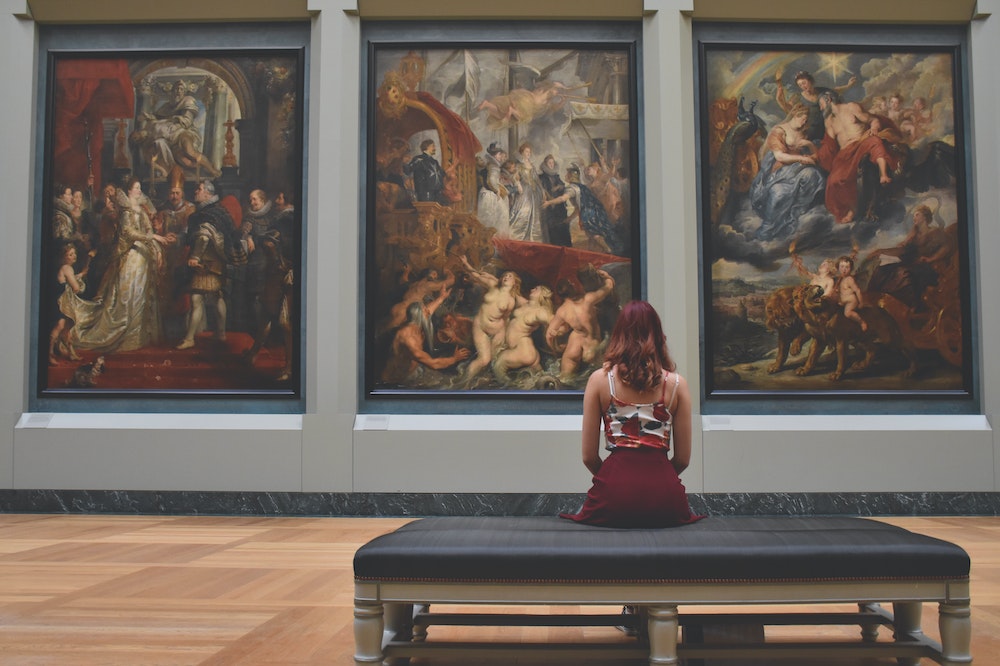Culture
 Photo from pexels.com
Photo from pexels.com
The Average Person’s Guide to Approaching Museum Art
March 2, 2023 @ 12:00pm
On any given D.C. museum trip, most visitors brush dangerously close to fragile sculptures, ignore the religious art galleries and make their pilgrimage to Impressionism to take selfies with a Van Gogh or Renoir.
Hushed comments like, “I could have done that” gently echo throughout the modern art galleries, at which point guests often start thinking about what they might want for lunch. Hidden silently in the corners of these episodes are the doting museum guides, so passionate about art history that they want to amplify the experience for others.
“There is something about the space around a work, about being in the presence of something beautiful that draws us in,” says Eryn Peak, a Glenstone Museum guide. “This kind of pull that we see is why people want to get up next to things, see something from different angles and experience it in a very physical way.”
As a practicing fine artist and Savannah College of Art and Design graduate, Peak has forged her lifelong interest in art to a career path, using her museum guide job as her entry into the art industry. While she normally encourages guests to experience work in any way accessible to them, she often has to interrupt visitors who become so captivated by a painting, they want to have a tactile experience.
“I get that compulsion, but the biggest thing is don’t touch,” she says.
In a more hands-off approach, museum guides and exhibiting artists alike have the same advice for viewers of artwork: to approach it with as much emotion as possible.
“Whenever you’re looking at art, I think it’s important to be honest with how it makes you feel,” says Jessica Devilbiss, a Maryland-based exhibiting oil painter. “A lot of times, people try to contextualize it in a way that’s educational or even scholarly, and I don’t think it needs to be all of that.”
Devilbiss’s paintings ruminate on themes of nostalgia, place and mental health but she enjoys when viewers walk away with a different interpretation.
“I find a lot of people try to figure out what the meaning is,” she says. “Ultimately it’s about the feeling you personally are getting from the artwork, not necessarily what the artist meant to say.”
Peak recommends applying these same emotional tools for works of art the viewer doesn’t particularly like, and trying to identify what details in the art are evoking those feelings.
“I think a lot of people are quick to dismiss a work they don’t understand, or that they think is telling them something they don’t like. There is something fun about not liking a work that sometimes adds to the experience.”
While wearing practical clothes and shoes helps alleviate the physical strain that comes from a day spent at a museum, doing so often makes people feel underdressed for the occasion because of the cultural air that surrounds gallery spaces.
“There is this sense that museums are a formal space,” Peak says. “I think people feel like they have to prove that they’re supposed to be here and letting go of that is important.”
Devilbiss suggests a simple mindset shift that elevates any museum experience.
“Some museums don’t always feel as welcoming as others, but I find that if you just welcome yourself into the space, that is most helpful.”
Glenstone Museum: 12100 Glen Rd. Potomac, MD; glenstone.org // @glenstonemuseum
4 Art Museums to Get You Started
NMWA always offers an empowering, feminist experience to visitors walking through its
galleries solely dedicated to female artists. NMWA is currently closed for renovations but will be
reopening this October. 1250 New York Ave. NW, DC; nmwa.org // @womeninthearts
View this post on Instagram
America’s first museum dedicated to modern and contemporary art is quietly tucked away in the
heart of Dupont Circle. The special exhibits are always powerfully thought-provoking, and the
permanent Rothko Room is a sweet meditative space. $10-$16. 1600 21st St. NW, DC; phillipscollection.org // @phillipscollection
View this post on Instagram
The AMA of The Organization of American States (OAS) holds one of the largest American
collections of contemporary Latin American and Caribbean art. The architecture and gardens of
this museum are just as breathtaking as the works housed inside. Free. 201 18th St.
NW, DC; museum.oas.org // @amamuseum
View this post on Instagram
Glenstone integrates its expansive collection of post-World War II artwork with thoughtful
architecture and tranquil nature, creating a serene space for guests away from the bustle of the
city. Free. 12100 Glen Rd. Potomac, MD; glenstone.org // @glenstonemuseum
View this post on Instagram







